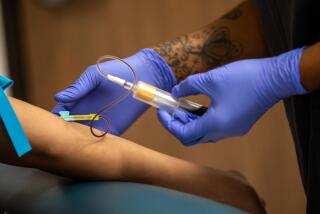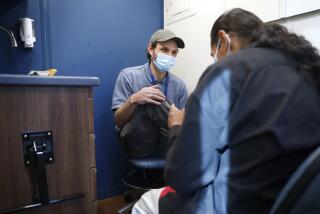The Epidemic of Tests Can Make You Sick : Health care: Good intentions gone awry lead to treating problems that may never get worse or may go away.
- Share via
While the President is speaking about the need to eliminate waste in health care, American hospitals are making thousands sick by peddling potentially harmful diagnostic tests. Like the “loss leaders” of supermarket and discount scores, free diagnostic tests are being offered across the nation--tests that will undoubtedly lead to subsequent purchases.
Many questions have been raised about the tests’ accuracy and, more importantly, about the utility of treatment for the diseases they purport to detect. Nevertheless, many people are in the midst of becoming patients. Some will get treated and some will die as a result.
The very week that President Clinton unveiled the American Health Security Act was “National Prostate Cancer Awareness Week,” when hospitals around the country offered free testing. Diagnostic advances such as ultrasound, magnetic resonance imaging and biochemical markers (such as the prostate-specific antigen or PSA) foster an intensive and expensive search for disease, which now identifies many subtle conditions that could not have been found a few decades ago. So more of us have now become patients as milder cases of disease, often without symptoms, are found. And diagnosis begets treatment that may not be necessary, may not work and even may lead to harm.
New diagnostic tests have made a number of diseases appear to be spreading at an alarming rate. While only about 1% of men between the ages of 60 and 70 have prostate cancer that can be detected in a physical exam, evidence of the disease is found in more than 40% of men in this age group when prostate tissue is examined under the microscope. So as men are increasingly tested with PSAs, ultrasound and MRI, the reported prevalence of prostate cancer increases.
Women are not spared the consequences of new diagnostic tests either. While about 1% of women 40 to 50 have cancerous lumps that can be felt, microscopic evidence of breast cancer is found in nearly 40% of women 40 to 50. As mammography is used more, the reported prevalence of breast cancer increases.
The increased ability of diagnostic tests to detect disease is believed to represent progress. But for the progress to be real, detection must benefit people beyond telling them they are sick; treatment for these newly detected diseases must be both necessary and effective.
Treatment may not be necessary. In addition to overt cases of disease, new tests also find milder cases--smaller, more slowly progressive abnormalities. Doctors can no longer assume that these newly found cases represent an early stage of a process that will ultimately be a threat to their patients. The tests also detect trivial anomalies, best described as “psuedo-disease.” Some anomalies will remain dormant for life; some may actually disappear. Recent findings, for example, suggest that the bulk of patients detected with prostate cancer are better off untreated.
Treatment may not be effective. While many treatments offer some benefits, all have some risks. Some can even kill you. The major therapy for prostate cancer leads to death 2% of the time in the elderly. Unfortunately, only a tiny fraction of treatments have been well tested. Thus doctors and patients often depend on historical comparisons. For example, since patients diagnosed with prostate and breast cancer live longer today than they did 20 years ago, most assume that treatment has improved. But survival is measured from the time of diagnosis. Because they are diagnosed earlier, patients live longer even if treatment has no effect.
If diagnostic tests detect conditions that do not necessarily require treatment and treatment does not necessarily work, why are they proliferating so rapidly? Part of the reason is, of course, economic--there are strong financial incentives for more testing. Another part is the public’s enthusiasm with prevention; more is always better. But even without such influences, the proliferation is largely promoted by good intentions--intentions that are misplaced because of everybody’s overestimation of how common disease is and how well treatment works.
These misconceptions occur in other diseases as well. All of us are now more likely to be diagnosed with heart disease, gallstones, slipped disks and phlebitis, whether or not we have symptoms, the diagnoses are responsible for our symptoms or we would be helped by treatment.
As we talk about providing health care for all, we must be attentive to what constitutes disease. The past two decades have produced dramatic advances in diagnostic technology, and many people have benefited. But others may have been labeled with diseases they really didn’t have or given therapy they didn’t need. The costs have been enormous. Reducing such testing would not only save money, but also might keep us from getting sick.






